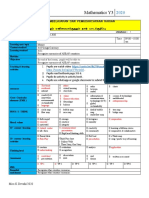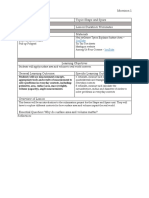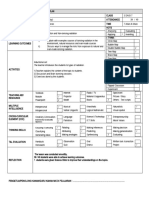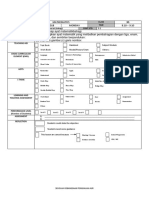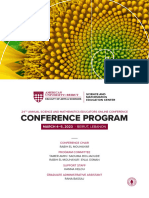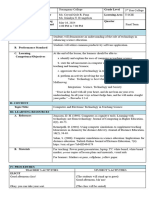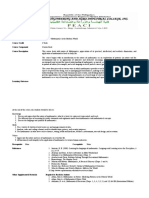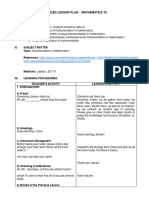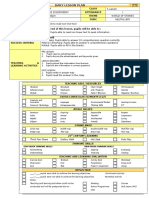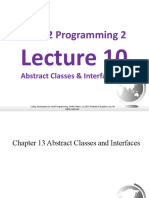2019 Research Conference Overview
2019 Research Conference Overview
Uploaded by
Achsanu NadiyaCopyright:
Available Formats
2019 Research Conference Overview
2019 Research Conference Overview
Uploaded by
Achsanu NadiyaOriginal Description:
Copyright
Available Formats
Share this document
Did you find this document useful?
Is this content inappropriate?
Copyright:
Available Formats
2019 Research Conference Overview
2019 Research Conference Overview
Uploaded by
Achsanu NadiyaCopyright:
Available Formats
NCTM 2019 Research Conference REGISTRATION Infinity Bar @ NCTM Research Conference Research Report Research Symposium Invited
Infinity Bar @ NCTM Research Conference Research Report Research Symposium Invited Session
Monday 4:00 p.m.–6:00 p.m. The Infinity Bar offers attendees the opportunity to meet with senior scholars and leaders in the field. Legend Discussion Session Poster Session Opening/Plenary Session
Schedule-at-a-Glance: Monday/Tuesday Tuesday 7:30 a.m.–2:00 p.m. Infinity Bar sessions follow the conference program. No sign-up is necessary. Just come and grab a seat at the table.
Room 29A Room 29B Room 29C Room 29D Room 30AB Room 30C Room 30DE Room 31AB Room 31C Room 32A
Monday #1. Opening Session Room 33 ABC
5:30 p.m.–
7:00 p.m.
What Is the Responsibility of the Mathematics Education Research Community
to Address Local, National, and Global Issues?
Deborah Loewenberg Ball, Na’ilah Suad Nasir, Kathryn B. Chval
Tuesday #2. Exploring Volume #3. Postulating Two Types of #4. Comparing Sensitivitiy #5. Investigating Student Thought #6. What’s in a Name? A Study of #7. Using Number Talks to Support #9. Making Mathematics #11. Examining Students›
8:30 a.m.– Measurement Dynamically Mathematical Concepts and of Video and Artifact-Based via Scratch Work for a Large-Scale Mathematics Teachers’ Implicit Bias the Development of a Math-Talk Connections Visible Opportunities to Engage
9:45 a.m. (Panorkou) How They Develop Observations of Teaching Assessment (Copur-Genturk, Cimpian, Theule Lubienski, Community through Problem Solving with Mathematics in High
Promoting Young Children’s (Simon) (Kelly, Stein) (Hass) Thacker) (Woods) and Dialogue School
Spatial Visualization through Explicit vs. Implicit Teaching Elementary Teachers› Use of Computer Generated Graphic One University’s Story on Teacher Professional Learning Community: (Koch, Suurtamm) (Jansen, Middleton, Tarr, Edusei,
Defining Practices Concerning Strategies for Digital Instructional Resources Organizer’s Effect on Learning Preparation in Elementary Mathematicians and Writers Curtis, Discussant: Goldin)
(Wongkamalasai) Problem Solving in 4 Countries Outcomes Mathematics (Santarone, Abney, Webb)
(Portnov Neeman, Amit) (Remillard) (Rugh, M. Capraro, R. Capraro) (Thomas)
10:00 a.m.– #13. A Framework for #14. Using Learning Progressions #15. Empowering Students #16. Teachers Eliciting Students› #17. “It Just Got Real”: Backing into #18. Discovering Square Roots: #19. Common Methodological #20. Mathematical #21. Preservice Teachers #22. Differentiating
11:15 a.m. Analyzing Secondary Students’ to Design and Assess Geometry in Learning Proof: Balancing Mathematical Arguments Social Justice Productive Struggle in Middle School Errors in JRME Submissions Authority: Gateway to [RE] Learning the Meaning Instruction in Mathematics
Covariational Reasoning Curricula Agency and Authority (Francisco) (Thanheiser, Felton-Koestler, Rosencrans, Osa, Mathematics (Cai, Shih, Empson, Wood) High Quality Classroom of Multiplication of Education
(Cavey, Totrica, Libberton, Carney, Souders) (Battista) (Pair, Reed, Bleiler-Baxter) Koestler) (Cattey) Discourse Fraction (Hackenberg, Silva, Jones,
Quantitative Reasoning among A Study to Examine Preservice The Role of the Two-Column Inservice Teachers› Distinctions (Sullivan, Evans) (Gichobi) MacDonald, Hunt, Roxburg)
Linguistically Diverse Middle Teachers’ Understanding of the Proof in the High School Between Quadratic and Exponential
School Students Quadrilaterals Geometry Classroom Growth
(Zahner, Lara-Meloy, Kim) (Bharaj, Cross Francis) (Pair, Singh, Strachota) (Vishnubhotla)
11:30 a.m.– #24. Developing Measures of #25. Reasoning with Ratios: #26. Discourse that Empowers #27. Improving Children’s Fraction #28. Synthesizing Measures of K–12 #29. Integer Problem Types and Their #30. ICME, International #31. Mathematical #32. Enhancing Elementary #33. Researching
12:45 p.m. Mathematical Proficiency in a As Composed Units or as Self in the Learning of Understanding through the Use of Students’ Math Knowledge Relationship to Children’s Thinking Perspectives, and Modeling with Cultural and Mathematics Instruction: A Synchronous Online
Learning Technology Multiplicative Comparisons? Mathematics Number Line (Bostic, Shih, Krupa, Carney) (Lamb, Bishop, Philipp, Whitacre) Opportunities Community Contexts in U.S.China Collaboration Content-Focused
(Hulse, Harrison, Manzo, Sawrey, Ottmar) (Aydeniz) (Chapman) (Soni, Okamoto) Connecting Mathematical Knowledge Properties of Equality and Operations: (Burrill) Grades 3–5 (Ding, Seidman, Larese, Milewski, Mathematics Coaching
Development of Diagnostic Grounded in Common Sense?: Elementary Teachers’ Math Intervention for Improving Struggling and Dispositions with Pedagogical How Do 3rd Graders Think? (Foote, Aguirre, Roth McDuffie, Murray, Discussant: Cai) (Amador, Carson, Gillespie,
Assessments in Probability for Examining Contextual Anxiety and Implications for 5th-Graders’ Fractions Achievement Skills (Yagi, Zenigami) Turner) Discussant: Elliott)
Middle Graders References in a Ratio Unit Self-Evaluation (Jayanthi, Karp, Schumacher, Gersten) (Shaughnessy, Boerst)
(H. Lee) (Reinke, Casto, Ayan, Stephan) (Kearns, Hone)
1:45 p.m.– #35. How a MOOC for Educators #36. A Model for Teacher #37. Operationalizing Evaluative #38. Examining Teacher Learning #39. Examining Domains of Teacher #40. Key Indicators of Mathematically #41. Detracking in Action: #42. Learning From Each #43. The Impact of #44. Middle Grades and
3:00 p.m. Can Make a Large Impact Candidate Attentiveness to Listening-to-Question in through Shifts in Teachers’ Enacted Knowledge in a Lesson Study Responsive Classrooms Stories, Opportunities, and Other: A Conversation Simulation Features on the High School Students
(H. Lee, Mojica, Azmy, Barker) Student Thinking Mathematics Teaching Identity Experience (Bishop, Przybyla-Kuchek, Hamilton) Challenges Around Extending 30 Years Learning MKT Three-Dimensional
Transforming Teachers’ (Carney, Cavey, Totorica) (Kuehnert, Eddy, Pratt) (Munson) (Erbilgin) Does Disability Matter In Mathematics Detracking to Support of CGI (Boerst, Pfaff) Reasoning
Understandings About Critical Embodied Noticing Preservice Mathematics The Impact of Professional Identity on Education Research? A Research Equity: The San (Empson, Franke, Jacobs) (Tillema, Lee, Barrett)
Distribution (Mendoza, Hand) Teachers’ Lesson Launch Quality of Mathematics Instruction Review Francisco Story
(Peters) Considerations (Flessner, Liu, Lloyd, Bharaj) (Lambert, Tan) (Torres, Hull, Barnes)
(Amador) A Systemic Way to
Approach Change:
Transforming
Mathematics Education
(Leaf, Meyer, Lawler)
3:15 p.m.– #46. Mathematics for #47. The Predictive Validity of an #48. Preservice Teachers’ #49. Beyond Correctness: Strategy #50. A Participatory Approach to #52. But what about #53. Components of #54. Mixed Methods #55. Math Instructional
4:30 p.m. Democracy? Algebraic Reasoning Universal Representational Fluency and Use in Multiplicative Reasoning Mathematics Teacher Noticing Equity? Examining Equity Professional Development Research Synthesis: Supports and Assessments
(Raygoza) Screener Functional Reasoning Performance (Hand, Mendoza, van Es) as a Collective Professional that Lead to Change in Addressing Complexity in for Students Learning
Rehumanizing Mathematics: (Adams, Ketterlin Geller) (Altindis, Fonger) (Ebby, Nathenson) Responsibility Teaching Math Education English
Historical and Cultural Students’ Mathematical Framing a Task as Both Additive Reasoning as Disabler (Celedón-Pattichis, Boote Goffney, (Garcia, Shaughnessy, Mortimer, Pfaff, (Chimuma) (Nikula, Zahner, Schultz, Neumayer,
Recontextualization Capabilities in Mediated Field Construction and Proof: How Do of Fraction Reasoning: Where is Larnell, Lunney Borden, Males, Pynes) Bergey)
(Moore, Slavit) Experiences Teachers Manage? Disability? Peters)
(Wilson, Sharpe) (Milewski, Bardelli, Herbst) (Hunt, Martin, Patterson)
4:30 p.m.– #57–119. Poster Session – Reception in Ballroom 20D
6:00 p.m.
Learn more at www.nctm.org/researchconference or download our app at www.nctm.org/confapp.
Connect with other attendees by using #NCTMresearch on Twitter, Facebook, and Instagram.
NCTM 2019 Research Conference REGISTRATION Learn more at www.nctm.org/researchconference or download our app at www.nctm.org/confapp. Research Report Research Symposium Invited Session
Monday 4:00 p.m.–6:00 p.m. Connect with other attendees by using #NCTMresearch on Twitter, Facebook, and Instagram. Legend Discussion Session Poster Session Opening/Plenary Session
Schedule-at-a-Glance: Wednesday Tuesday 7:30 a.m.–2:00 p.m.
Room 29A Room 29B Room 29C Room 29D Room 30AB Room 30DE Room 31AB Room 31C Room 32A Room 33ABC
Wednesday #120. Exploring Coordinates #121. Sketchnotes: A #122. Using Pitfalls to Support #123. Teachers Dealing with #124. Design Features of Digital Math #126. MET Grant Research: Second- #128. Math-as-Discourse & #129. Equity in K–12 #130. NCTM President’s
8:00 a.m.– Using Coding Communication Tool to Middle School Mathematical Nonstandard Student Solutions to Games through the Lens of Grade Urban Students’ Sense of Sci-Fi Futures: Perspectives Mathematics Education: Session: Researchers as
9:15 a.m. (Germia, Panorkou) Strengthen Research and Discussion and Equity Linear Equations ACAT Fraction Magnitude; and Infusing on MTs› Prep for SJ Highlights from a National Advocates for Mathematics
Learning from Dialogic Online Practice Links (D’Silva) (Milewski, Chazan, Herbst) (Moyer-Packenham, Litster, Ashby, Roxburgh, History into Mathematics Instruction (Warburton, Rezvi, Gutiérrez) Survey Teaching and Learning
Mathematics Videos (Fonger) Who Is Math? Drawings and Addressing the Computer Science & Bullock) (Connelly, Powell, Son, Martey) (Malzahn, Gordon, Plumley, (Berry)
(Lobato) Impact of Electronic Notebooks Texts Tell Stories of Healing Math Debate with a Catalyzing Change Digital Math Games: Affect, Discussant: Heck)
on Teacher Educator from Math Trauma Lens Vocabulary, and Strategy Influences on
Instructional Decisions (Ruef, Willingham) (Zelkowski) Learning
(Gallivan) (Litster, Moyer-Packenham, Ashby, Roxburgh)
9:30 a.m.– #131. Plenary Session – Room 33ABC
11:00 a.m.
Learning, Identity, and Power in a Collaborative World
Jennifer M. Langer-Osuna
11:15 a.m.– #132. Embracing Change #133. Prospective Teachers› #134. What Can Mathematics #135. Making Sense of Teachers’ #136. Diagnosing Reasoning to #138. Sharing Research with Classroom #139. Making Sense of #140. Exploring Dynamic #141. Examining Classroom- #142. Linking Research
12:30 p.m. Agency: Practical Lessons from Development of Knowledge of Teacher Educators Do to Varied Responses to Representations Measure Future Teachers’ Facility with Teachers: Writing for MTLT Identity and Sense of Learning Technologies for Based Professional and Practice: Productive
Secondary Classrooms Mathematical Modeling Develop Their Knowledge Bases? of Practice Fractions (Barlow, Adams) Belonging in Mathematics Experiencing Algebraic Learning Models Struggle for All Students
(Gates, Badertscher, Sword, MacDowell) (Zhao) (Prasad, Patterson,Vallines Mira, Liang) (Jackson, Nieman, Kochmanski) (Olmez, Izsak) (Kress, Gilmore) Notation (Davenport, Lewis, Board, Using Differentiated
Opportunities for Student Modeling as a Mean of Fostering The Moderating Effect of A Fraction Sense Intervention for (Sawrey, Ottmar, Hulse) Shaughnessy, Gibbons, Discussant: Instruction
Agency in Math Lessons with/ Creativity and Multicultural Student-Teacher Relationship Struggling Middle School Math Davenport) (Lewis, Hunt, Lynch)
out Interactive Sims Equity on Math Learning Students
(Atabas, Whitacre, Schellinger) (Amit, Gilat) (Flores, Lan) (Dyson, Jordan)
1:30 p.m.– #143. K–8 Mathematics Teachers’ #144. What Online Resources #145. Developing Math Teacher- #146. Identifying the Differential #147. The Effects of Informal Learning #149. Writing MTE Manuscripts: #150. The Arc of Learning #151. Syllabus Subject to #152. Mathematical #153. Linking Research
2:45 p.m. Beliefs About Mathematical are Elementary Mathematics Leaders in Rural Schools: A Impact of an Individualized Coaching on Student Interest in STEM Fields Using the Writing Tool to Guide the Framework: Building Change; or Transforming Engagement IS and Practice: Strategies
Aptitude Teachers Using? Yearlong PD Experience Approach (Bicer,Y. Lee) Communication of Your Ideas Learning Over Time Assessment with Specs Fundamentally an Equity for Bulding Caring
(Copur-Genturk, Thacker, Quinn, Brayer (Dick, Shapiro, Sawyer, Wisner) (Anderson-Pence) (Cross Francis) (Hollebrands, MTE Editorial Panel) (Edson, Phillips, Slanger-Grant) Grading Issue Relationships in Math
Ebby) MTEs Learning through Lesson Studying the Sustained Impacts Using Rehearsal to Grow Shared (C.D.Walters) (Badertscher, Gates, Boston, Classrooms
Teacher Views of Non-Cognitive Study: A Community of Practice of Professional Development Expertise in a Community of Teacher Discussant: Spencer) (Hunsdon, Neal, Battey)
Traits Key to Success in 8th Perspective (Plumley, Heck, Hoover, Malzahn) Leaders
Grade Algebra (Appelgate, Dick, Soto, Gupta) (Nickerson,Vaughn)
(K. Walters, Eisner, Sorensen, Gorsky)
3:00 p.m.– #154. Exploring Gravity Through #155. Teacher-Designed #156. Teachers’ Shifting #157. Impact of Professional #158. Gender Difference on Spatial #160. Research in Math Education and #162. Refreshing High #163. Collaborating to #164. Linking Research and
4:15 p.m. Mathematics Mathematical Modeling Routines Perceptions of the Standards for Development for Math Teachers of Visualization (STEM vs non-STEM) STEM: Panel Discussion School Curriucula with Improve the Preparation Practice: Inverse Functions:
(Panorkou, Basu) for Secondary Classrooms Mathematical Practice English Learners (Y. Lee, R. Capraro, Bicer, M. Capraro, Park) (Hjalmarson, Asbell-Clarke, Gresalfi) Mathematics-News- of Secondary Mathematics Why Switch the Variables?
The Use of Task Templates to (Elliott, Knapp) (Davis, Seiwell) (Buffington, Neumeyer DePiper, Louie, Nikula) Interactional Pathways to Shared Snapshots Teachers (Teuscher, Palsky, Palfreyman)
Guide Design Activity Secondary Mathematics Change in Pre-service Teachers’ Examining the 12th-grade Intellectual Authority During Group (Movshovitz-Hadar) (Amick, Franz, Lischka, McNamara,
(Cannon) Teachers’ Descriptions of Conceptions of Mathematics Mathematics NAEP: Validity Work Smith, Strutchens, Discussants:
Mathematical Practices Teaching Considerations for ELLs (Langer-Osuna, Gargroetzi, Munson, Williams, Lawler, Martin)
(Wynn) (Kartal, Tillett) (Runnalls) Chavez)
Infinity Bar @ NCTM Research Conference
The Infinity Bar offers attendees the opportunity to meet with senior scholars and leaders in the field.
Infinity Bar sessions follow the conference program. No sign-up is necessary. Just come and grab a seat at the table.
NCTM Bookstore
The NCTM Bookstore opens at 10 a.m. on Wednesday, and you will save 25% off the list price on all purchases made onsite.
The Bookstore is located in Exhibit Hall G of the San Diego Convention Center.
NCTM Central
NCTM Central opens at 10 a.m. on Wednesday. Find the answers to all your NCTM membership questions, and learn about
NCTM grants, professional development offerings, and what is coming next from NCTM.
Linking Research and Practice Day @ Research Conference
NCTM Annual Meeting attendees are welcome to participate in sessions focusing on linking research and practice
at the NCTM Research Conference.
You might also like
- Week 3-6 Effect of UV On Yeast S18Document6 pagesWeek 3-6 Effect of UV On Yeast S18BlackBunny103No ratings yet
- Bioinformatics Toolbox™ User's Guide PDFDocument351 pagesBioinformatics Toolbox™ User's Guide PDFVictor Colpo NavarreteNo ratings yet
- Aral2019 Program PortraitDocument8 pagesAral2019 Program PortraitAldrich ONo ratings yet
- RPH Minggu 2 2024 (Isnin)Document4 pagesRPH Minggu 2 2024 (Isnin)salbahernasernaNo ratings yet
- RPH Minggu 10 2024Document18 pagesRPH Minggu 10 2024salbahernasernaNo ratings yet
- RPH Minggu 7 2024 (Isnin)Document4 pagesRPH Minggu 7 2024 (Isnin)salbahernasernaNo ratings yet
- Mathematics Y3: Rekod Pembelajaran Dan Pemudahcaraan Harian Üèöõ Ç Áâ¡Ìì Öõ ¿¡Û À¡ Ììè ÔòDocument1 pageMathematics Y3: Rekod Pembelajaran Dan Pemudahcaraan Harian Üèöõ Ç Áâ¡Ìì Öõ ¿¡Û À¡ Ììè ÔòK.DEVAHI A/P KRISHNAN MoeNo ratings yet
- Mathematics Y3: Rekod Pembelajaran Dan Pemudahcaraan Harian Üèöõ Ç Áâ¡Ìì Öõ ¿¡Û À¡ Ììè ÔòDocument1 pageMathematics Y3: Rekod Pembelajaran Dan Pemudahcaraan Harian Üèöõ Ç Áâ¡Ìì Öõ ¿¡Û À¡ Ììè ÔòK.DEVAHI A/P KRISHNAN MoeNo ratings yet
- Inset 2016Document28 pagesInset 2016Leizel Aycocho ValenzuelaNo ratings yet
- Mathematics Y3: Rekod Pembelajaran Dan Pemudahcaraan Harian Üèöõ Ç Áâ¡Ìì Öõ ¿¡Û À¡ Ììè ÔòDocument2 pagesMathematics Y3: Rekod Pembelajaran Dan Pemudahcaraan Harian Üèöõ Ç Áâ¡Ìì Öõ ¿¡Û À¡ Ììè ÔòK.DEVAHI A/P KRISHNAN MoeNo ratings yet
- Mathematics Y3: Rekod Pembelajaran Dan Pemudahcaraan Harian Üèöõ Ç Áâ¡Ìì Öõ ¿¡Û À¡ Ììè ÔòDocument2 pagesMathematics Y3: Rekod Pembelajaran Dan Pemudahcaraan Harian Üèöõ Ç Áâ¡Ìì Öõ ¿¡Û À¡ Ììè ÔòK.DEVAHI A/P KRISHNAN MoeNo ratings yet
- Mathematics Y3: Rekod Pembelajaran Dan Pemudahcaraan Harian Üèöõ Ç Áâ¡Ìì Öõ ¿¡Û À¡ Ììè ÔòDocument2 pagesMathematics Y3: Rekod Pembelajaran Dan Pemudahcaraan Harian Üèöõ Ç Áâ¡Ìì Öõ ¿¡Û À¡ Ììè ÔòK.DEVAHI A/P KRISHNAN MoeNo ratings yet
- Mathematics Y3: Rekod Pembelajaran Dan Pemudahcaraan Harian Üèöõ Ç Áâ¡Ìì Öõ ¿¡Û À¡ Ììè ÔòDocument2 pagesMathematics Y3: Rekod Pembelajaran Dan Pemudahcaraan Harian Üèöõ Ç Áâ¡Ìì Öõ ¿¡Û À¡ Ììè ÔòK.DEVAHI A/P KRISHNAN MoeNo ratings yet
- Mathematics Y3: Rekod Pembelajaran Dan Pemudahcaraan Harian Üèöõ Ç Áâ¡Ìì Öõ ¿¡Û À¡ Ììè ÔòDocument2 pagesMathematics Y3: Rekod Pembelajaran Dan Pemudahcaraan Harian Üèöõ Ç Áâ¡Ìì Öõ ¿¡Û À¡ Ììè ÔòK.DEVAHI A/P KRISHNAN MoeNo ratings yet
- Math Project 2023Document10 pagesMath Project 2023api-657919781No ratings yet
- Mathematics Y3: Rekod Pembelajaran Dan Pemudahcaraan Harian Üèöõ Ç Áâ¡Ìì Öõ ¿¡Û À¡ Ììè ÔòDocument2 pagesMathematics Y3: Rekod Pembelajaran Dan Pemudahcaraan Harian Üèöõ Ç Áâ¡Ìì Öõ ¿¡Û À¡ Ììè ÔòK.DEVAHI A/P KRISHNAN MoeNo ratings yet
- Subject Class Date / Day Time Topic Cont - STD Learning Standard ActivitiesDocument2 pagesSubject Class Date / Day Time Topic Cont - STD Learning Standard ActivitiesrazudaNo ratings yet
- RPH MINGGU 16 2024 (Isnin)Document4 pagesRPH MINGGU 16 2024 (Isnin)salbahernasernaNo ratings yet
- RPH Minggu 16 2024Document19 pagesRPH Minggu 16 2024salbahernasernaNo ratings yet
- Mathematics Y3: Rekod Pembelajaran Dan Pemudahcaraan Harian Üèöõ Ç Áâ¡Ìì Öõ ¿¡Û À¡ Ììè ÔòDocument2 pagesMathematics Y3: Rekod Pembelajaran Dan Pemudahcaraan Harian Üèöõ Ç Áâ¡Ìì Öõ ¿¡Û À¡ Ììè ÔòK.DEVAHI A/P KRISHNAN MoeNo ratings yet
- CAHP 2021 - 2022 Mathematics in The Modern World Weekly ScheduleDocument15 pagesCAHP 2021 - 2022 Mathematics in The Modern World Weekly ScheduleJEUEL DYLAN DINSAYNo ratings yet
- MMW BS BioDocument12 pagesMMW BS BioMikhail LandichoNo ratings yet
- PRIMALS EditedDocument9 pagesPRIMALS EditedMary An NepomucenoNo ratings yet
- Rancangan Pengajaran HarianDocument26 pagesRancangan Pengajaran HarianYogamalar ChandrasekaranNo ratings yet
- AEA 2023 SimpleProgram 12.10.2023 08.10Document17 pagesAEA 2023 SimpleProgram 12.10.2023 08.10AsmaaNo ratings yet
- PILLOS LESSON PLAN Pre Calculus11Document5 pagesPILLOS LESSON PLAN Pre Calculus11Hanna Lee PillosNo ratings yet
- Mathematics Y3: Rekod Pembelajaran Dan Pemudahcaraan Harian Üèöõ Ç Áâ¡Ìì Öõ ¿¡Û À¡ Ììè ÔòDocument2 pagesMathematics Y3: Rekod Pembelajaran Dan Pemudahcaraan Harian Üèöõ Ç Áâ¡Ìì Öõ ¿¡Û À¡ Ììè ÔòK.DEVAHI A/P KRISHNAN MoeNo ratings yet
- RPH TS25 Prasekolah Arivan 2020Document18 pagesRPH TS25 Prasekolah Arivan 2020Moggilavannan Arumugam100% (8)
- MELTA Proceeding 2023 PDFDocument4 pagesMELTA Proceeding 2023 PDFNeil JosephNo ratings yet
- Learning in Third SpaceDocument1 pageLearning in Third SpaceWendiNo ratings yet
- Relevance of Science EducationDocument20 pagesRelevance of Science EducationRia LeacockNo ratings yet
- Aral2019 ProgramDocument9 pagesAral2019 ProgramAumi ManansalaNo ratings yet
- Subject Class Date / Day Time Topic Cont - STD Learning Standard ActivitiesDocument2 pagesSubject Class Date / Day Time Topic Cont - STD Learning Standard ActivitiesrazudaNo ratings yet
- Alysa Simerson ST Observation 1 12Document3 pagesAlysa Simerson ST Observation 1 12api-624988942No ratings yet
- SMEC 24 ProceedingsDocument15 pagesSMEC 24 Proceedingslocifa3179No ratings yet
- Ternz Conference Programme 2010Document2 pagesTernz Conference Programme 2010AdisornJuntrasookNo ratings yet
- DEN PETE&C PreCon Schedule 2011Document4 pagesDEN PETE&C PreCon Schedule 2011rjstangherlinNo ratings yet
- Week 1 G10Document10 pagesWeek 1 G10Richel CastilloNo ratings yet
- Lesson Plan Namin Oh BakitDocument15 pagesLesson Plan Namin Oh BakitVanness Josh LunaNo ratings yet
- A Detailed Lesson Plan For Grade 10 Unit 4 - QuartilesDocument6 pagesA Detailed Lesson Plan For Grade 10 Unit 4 - QuartilesAlwin AsuncionNo ratings yet
- DU Pedagogy 2Document5 pagesDU Pedagogy 2Manish PandeyNo ratings yet
- 7es Detailed Lesson Plan in TscieDocument13 pages7es Detailed Lesson Plan in TscieCrystal Gyle FunaNo ratings yet
- Nagustan Elementary School School-Based In-Service Training For Teachers Training MatrixDocument1 pageNagustan Elementary School School-Based In-Service Training For Teachers Training MatrixJacquelyn ChuNo ratings yet
- GEC 113 Mathematics in Modern WorldDocument17 pagesGEC 113 Mathematics in Modern WorldmhadzmpNo ratings yet
- 7es DETAILED LESSON PLAN IN TSCIEDocument13 pages7es DETAILED LESSON PLAN IN TSCIECrystal Gyle FunaNo ratings yet
- Cot 2Document7 pagesCot 2Monica Abuyo Villaflores LptNo ratings yet
- 4a's Lesson Plan For Demo # 2Document5 pages4a's Lesson Plan For Demo # 2Ronel SuanNo ratings yet
- Exp. #7 - 2°Document20 pagesExp. #7 - 2°Jennyfer QZNo ratings yet
- Detailed Lesson Plan Myra (Math 18)Document8 pagesDetailed Lesson Plan Myra (Math 18)Myra ReyesNo ratings yet
- Math T1 Monday 31 OktDocument3 pagesMath T1 Monday 31 OktImelda D. JacksonNo ratings yet
- Lesson Plan Pak21Document2 pagesLesson Plan Pak21Syafinaz Salvatore100% (1)
- Mathematics Y3: Rekod Pembelajaran Dan Pemudahcaraan Harian Üèöõ Ç Áâ¡Ìì Öõ ¿¡Û À¡ Ììè ÔòDocument2 pagesMathematics Y3: Rekod Pembelajaran Dan Pemudahcaraan Harian Üèöõ Ç Áâ¡Ìì Öõ ¿¡Û À¡ Ììè ÔòK.DEVAHI A/P KRISHNAN MoeNo ratings yet
- Activity: Domain Instructional Emphasis: Common Core State StandardsDocument7 pagesActivity: Domain Instructional Emphasis: Common Core State StandardsPrathap c ReddyNo ratings yet
- Daily Lesson Plan 22Document1 pageDaily Lesson Plan 22Subashini LetchumananNo ratings yet
- Daily Lesson Plan: (I) (Ii) (Iii)Document4 pagesDaily Lesson Plan: (I) (Ii) (Iii)suhaini abidinNo ratings yet
- Mathematics Y3: Rekod Pembelajaran Dan Pemudahcaraan Harian Üèöõ Ç Áâ¡Ìì Öõ ¿¡Û À¡ Ììè ÔòDocument2 pagesMathematics Y3: Rekod Pembelajaran Dan Pemudahcaraan Harian Üèöõ Ç Áâ¡Ìì Öõ ¿¡Û À¡ Ììè ÔòK.DEVAHI A/P KRISHNAN MoeNo ratings yet
- Reflection 3Document8 pagesReflection 3Maria Pagasa MojadoNo ratings yet
- DLL 6TH Week StatisticsDocument8 pagesDLL 6TH Week StatisticsKristine Love Q. MorenoNo ratings yet
- Final Chapter123Document39 pagesFinal Chapter123Paolo De VeraNo ratings yet
- 2019 Template Lesson Plan Bi Sjkttr-BlankDocument1 page2019 Template Lesson Plan Bi Sjkttr-BlankravindarusmNo ratings yet
- DLP Clean-Module6 (Aas)Document6 pagesDLP Clean-Module6 (Aas)daiseryabecia143No ratings yet
- Mathematicians as Enquirers: Learning about Learning MathematicsFrom EverandMathematicians as Enquirers: Learning about Learning MathematicsNo ratings yet
- 1 X TRIGON L Plus Boiler LLH 1CT Heating Circuit 1 DHW Circuit With A CalorifierDocument4 pages1 X TRIGON L Plus Boiler LLH 1CT Heating Circuit 1 DHW Circuit With A Calorifieradyro12No ratings yet
- Can DIPPR Database Be Used For An EDocument7 pagesCan DIPPR Database Be Used For An Elight crow songNo ratings yet
- Preliminary Phytochemical and GC MS Analysis of Different Extracts of Sphaeranthus Indicus LeavesDocument10 pagesPreliminary Phytochemical and GC MS Analysis of Different Extracts of Sphaeranthus Indicus LeavesBaru Chandrasekhar RaoNo ratings yet
- INSET Day 2 3 Narrative Raport Jan 2024Document2 pagesINSET Day 2 3 Narrative Raport Jan 2024Simon ShaunNo ratings yet
- SPPU Earthquake Engineering - December 2016 Exam Question Paper - StupidsidDocument5 pagesSPPU Earthquake Engineering - December 2016 Exam Question Paper - StupidsidShaukat Ali KhanNo ratings yet
- Indian Air Force: (Valid For Male Candidates Only)Document5 pagesIndian Air Force: (Valid For Male Candidates Only)abhay trivediNo ratings yet
- 16 Inch ScrollDocument20 pages16 Inch ScrollToots AsensiNo ratings yet
- 2011 1 Training Manual On Material ManagementDocument119 pages2011 1 Training Manual On Material ManagementMaheshNo ratings yet
- Product Overview: Hybrid & Electric Mobility SolutionsDocument76 pagesProduct Overview: Hybrid & Electric Mobility SolutionsYan ChenNo ratings yet
- NomnuudDocument16 pagesNomnuudBilegee KhNo ratings yet
- Marigolds Skills Focus Questions and Sample AnswersDocument3 pagesMarigolds Skills Focus Questions and Sample AnswersqzweqwNo ratings yet
- C. The Material SelfDocument18 pagesC. The Material SelfPaul Winston RegaladoNo ratings yet
- Project Proposal: Raja Puniani HU SIEM, SiliguriDocument44 pagesProject Proposal: Raja Puniani HU SIEM, SiliguriRaja PunianiNo ratings yet
- Adobe Scan 17 Dec 2023Document5 pagesAdobe Scan 17 Dec 2023narenkalal87No ratings yet
- Instructions To Probationers IRSMEDocument124 pagesInstructions To Probationers IRSMEAshlin AugustyNo ratings yet
- Sheet Service - SKT90SDocument2 pagesSheet Service - SKT90SAnanda risaNo ratings yet
- Rubric For Immersion PortfolioDocument1 pageRubric For Immersion PortfolioleaNo ratings yet
- Assignment 02 Genetic AlgorithmDocument2 pagesAssignment 02 Genetic AlgorithmAhsaan HabibNo ratings yet
- Microwave Installation and CommisioningDocument54 pagesMicrowave Installation and CommisioningAli SharafNo ratings yet
- CAREER GUIDANCE Slides PresentationDocument54 pagesCAREER GUIDANCE Slides PresentationNur Izzati AdamNo ratings yet
- Monroe IslandDocument2 pagesMonroe IslandconniebaghariNo ratings yet
- Lister Petter Diesel AsDocument6 pagesLister Petter Diesel AsManuel Hincapie100% (1)
- The Langmuir Adsorption IsothermDocument5 pagesThe Langmuir Adsorption IsothermJerryson OrpillaNo ratings yet
- 15 01 2021 - 23053 - Apron FeedersDocument5 pages15 01 2021 - 23053 - Apron FeedersAlexis GodoyNo ratings yet
- 13 SlideDocument43 pages13 SlideMem MemNo ratings yet
- Physics PE 1Document3 pagesPhysics PE 1yanikwendu1No ratings yet
- Naveen Kumar Resume Format5Document2 pagesNaveen Kumar Resume Format5Satish KumarNo ratings yet
- Mittal School of Business Lovely Professional University Academic Task-2Document1 pageMittal School of Business Lovely Professional University Academic Task-2Puru RajNo ratings yet









